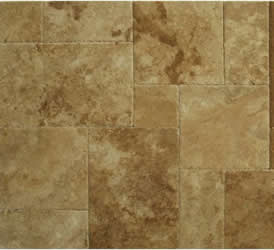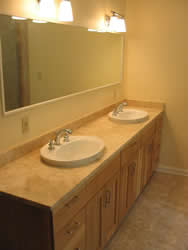
Figure 1 - Travertine/Onyx floor tile
Today travertine or onyx is used as a tile for residential and commercial flooring material, as shown in Figure 1; it is used in slabs to create countertops, as shown in Figure 2; fireplace mantels; large tiles for wall covering; milled into bathroom basins and is one of the most popular stones for carving by artisans.
Although many consider travertine to be a type of marble (onyx marble) it is much closer in composition and appearance to limestone. In the same manner as limestone, travertine is a porous natural stone that has pock marks or pits in it. These pits are usually filled and sealed in ordert to provide a smooth finish to the end floor tile, countertop or other product. The care taken to fill the holes (matching color) often determines the overall quality and hence the price of the finished travertine. With some of the less expensive travertine floor tiles, the fill is quite noticeable.
Travertine, like marble, generally has multi-colored veins running through the stone, and like marble the veining provides an elegance and warmth at the same time. The travertine material itself is available in egg shell whites to deep beige and even light and medium browns.
As floor and wall tiles travertine is available in wide variety of shapes and sizes. From 1 inch square on sheets of 12 x 12 to 18 inch square, brick shape and an assortment of rectangles.
Because it is a natural stone, no two pieces of travertine are identical. A typical travertine floor, as shown in Figure 1 or countertop, as shown in Figure 2, will have numerous shades of color blotches within it.
Travertine or onyx is generally less expensive than marble for like quality.
Most travertine and onyx is quarried in Turkey, Pakistan and Italy.
In residential applications travertine should be sealed to prevent it from absorbing stain producing liquids into the surface of the material. Areas, where travertine is installed that have high traffic or wear, such as floors and countertops, should be resealed on a regular basis. Although some homeowners may consider the need for sealing to be a disadvantage, all of the natural stones such as marble, granite, and limestone should be sealed regularly to prevent them from absorbing liquids and staining.

Figure 1 - Travertine/Onyx bathroom countertop
The biggest disadvantage to travertine or onyx is that overtime the fill used to make the surface smooth can become loose and will need to be replaced. Filling and then smoothing a travertine floor or countertop is not generally considered to be a home handyman project, as the color matching of the fill, which is critical to the overall appearance, requires a lot of expertise to create a professional finish.
Because this losing of the fill is related to the level of traffic or degree of cleaning of the travertine stone, the homeowner should consider if the location chosen to use travertine as the finish material is appropriate for the level of maintenance required.
